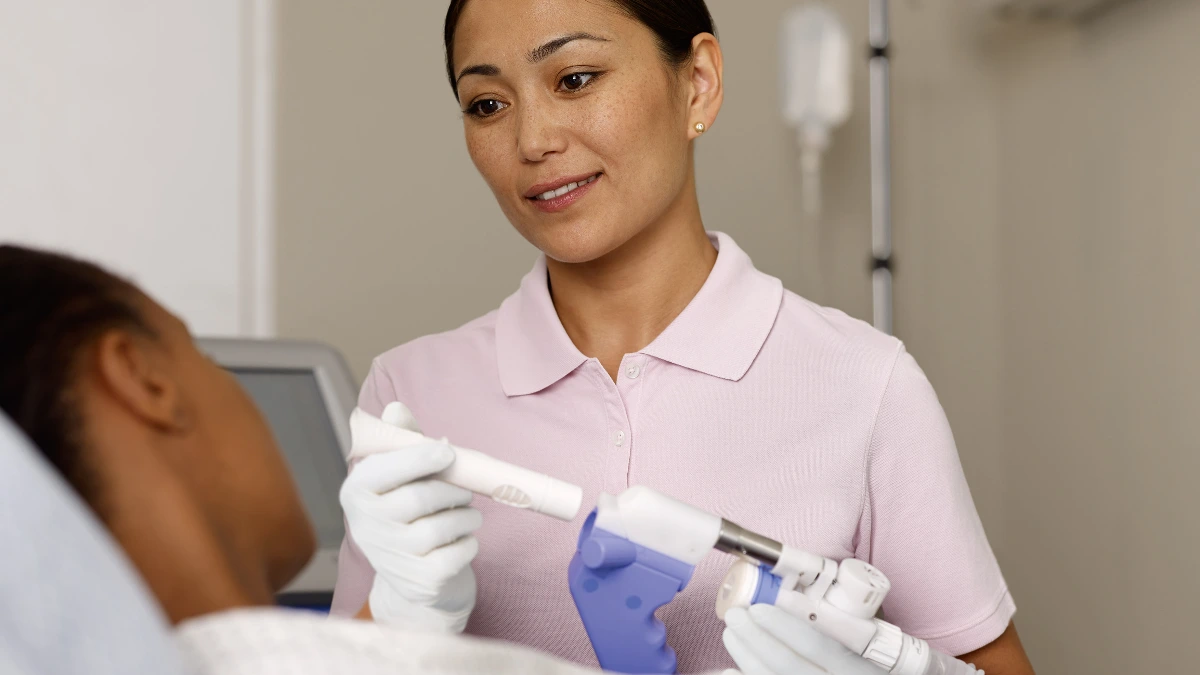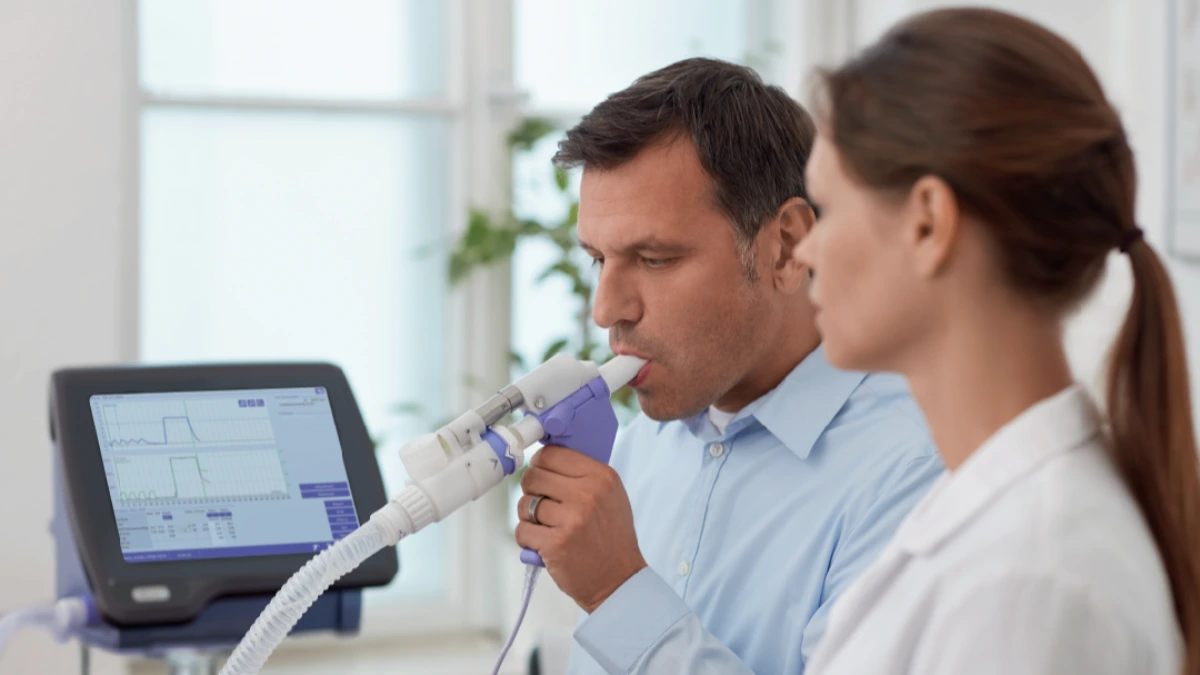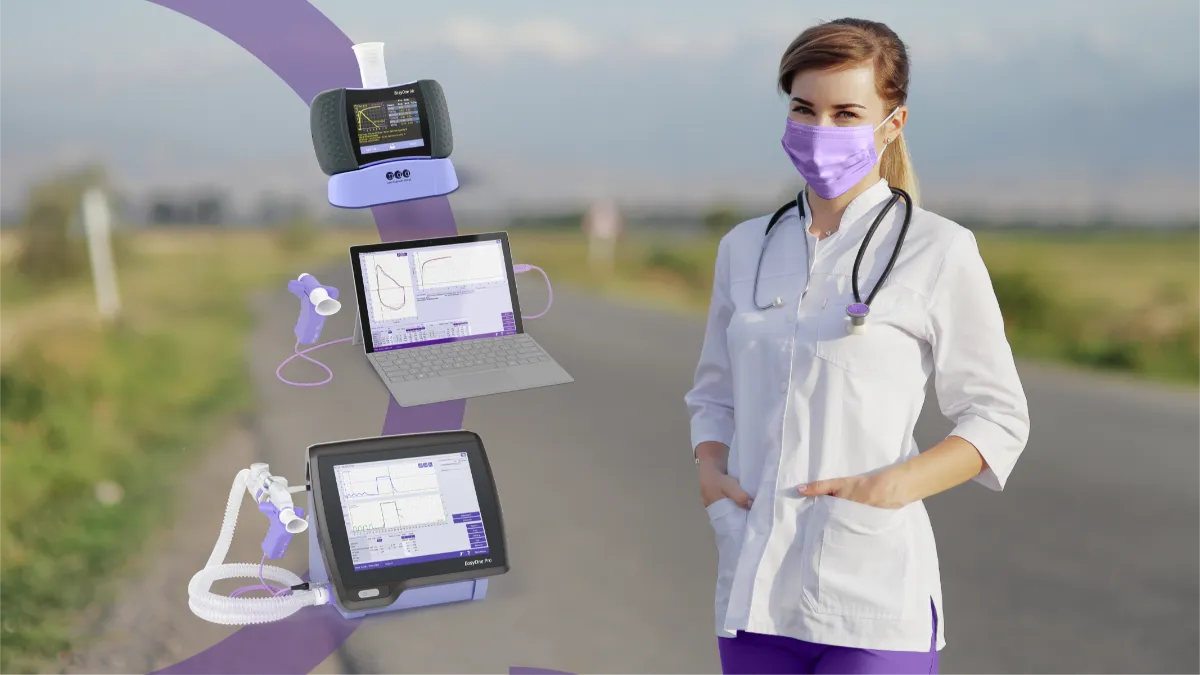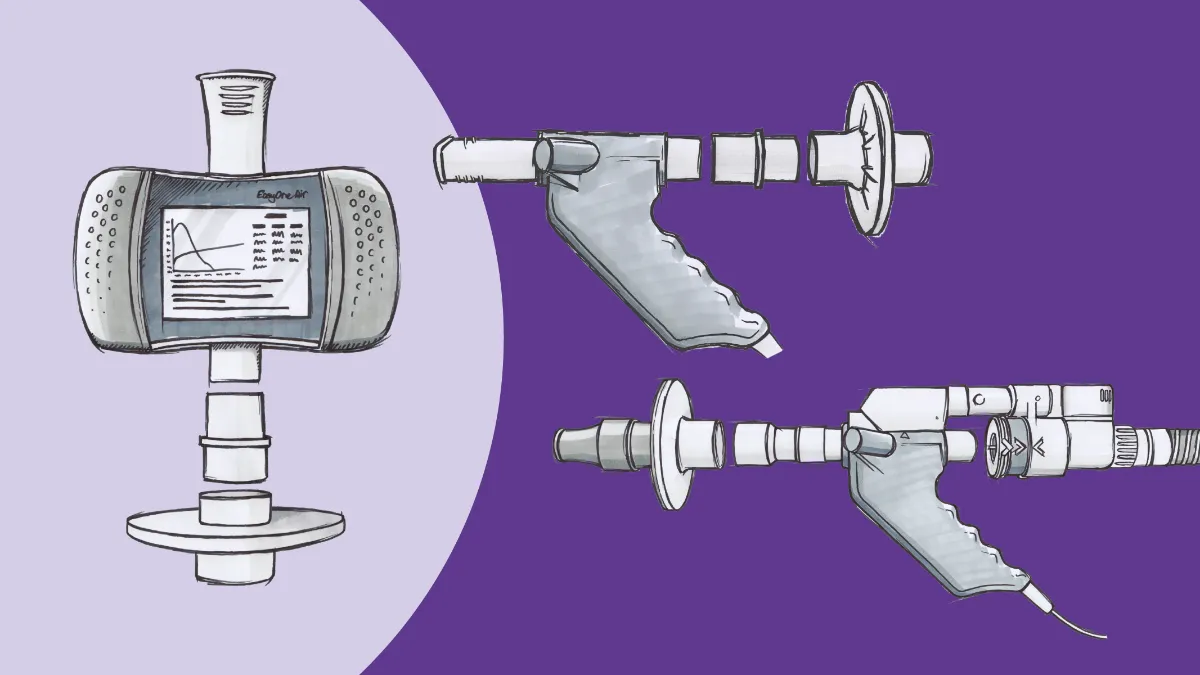Understanding lung function tests and their importance in respiratory health

Lung function tests play a critical role in respiratory health. Here we will take a comprehensive look at what they are, what types exist and what sets them apart, and how they can improve patients’ lives.
What are lung function tests anyway? #
Pulmonary function tests (PFTs), also known as lung function tests (LFTs), evaluatehow well the lungs function.1 There are many types of lung function tests including, but not limited to, spirometry, DLCO, and MBW. Tests vary in precision and capture different measurements.1
The word “test,” can invoke feelings of nervousness for patients as they wonder what the experience will be like. The good news is lung function tests are pain-free.1 A pulmonary function technician also guides patients through the steps before the test begins to ensure comfort.2 With their greatest effort, patients blow air out and breathe air in and then repeat the test several times.1
Different types of tests provide a more comprehensive picture #
Spirometry
Let’s first look at spirometry, the most well-known lung function test. Spirometry measures how much air you can breathe in and out of your lungs and how easily and fast you can blow the air out.
The test is done with the patient in a fully upright seated position, feet planted on the floor, chin slightly elevated, nostrils plugged, and lips tightly sealed over a mouthpiece that connects to the spirometer.2 While the patient takes a deep breath and then blows out the air quickly with maximum effort*,* the clinician observes to ensure the patient responds well and offers coaching and encouragement.2 The patient repeats the test at least three times and no more than seven or eight times.2
Physicians use spirometry results to diagnose and manage a variety of lung diseases including asthma and COPD.3 Spirometry can detect lung function issues even before symptoms appear.3 A patient’s gender, age, and height are factored into the results to determine if values are abnormal.4 Physicians may prescribe medications as needed and call for future spirometry testing for continued monitoring.4
Spirometry is an easy, non-invasive test that produces major results by detecting lung diseases early and managing their progression allowing patients to live healthier lives.
DLCO ** **
DLCO (diffusion capacity of the lung for carbon monoxide), also known as TLCO (transfer factor of the lung for carbon monoxide), is another type of lung function test.5 DLCO measures how well a gas mixture moves from the lungs to the bloodstream.
Once a patient has taken a spirometry test and patient data is entered, DLCO testing can begin.6 With a mouthpiece and nose clips on, the patient breathes normally and then takes a maximum unforced exhale.6 This is followed by a maximal inhalation in which the gas is released, a 10-second breath hold, and an unforced exhalation.6 After a short break, the test is repeated.6
DLCO and spirometry are a powerful combination that provide detailed information on how the lungs are performing.6 DLCO test results indicate lung disease severity, pulmonary vascular disease, and preoperative risk.7 The range of the results is an important indicator. For instance, a low DLCO and low KCO (Ratio of DLCO to VA (Alveolar Volume)) occur for COPD with emphysema, and a high DLCO is found with obesity and asthma.7
DLCO testing, done in cooperation with spirometry testing, provides additional information that enables physicians to hone in on a patient’s diagnosis.
MBW
Last on our list, but certainly not least, is the MBW (multiple breath washout) test.
For a healthy person, inhaled gases are efficiently and uniformly distributed in the lungs.8 However, if obstructive lung disease is present, uneven distribution occurs because the peripheral airways are narrowed or obstructed.8
That’s where the MBW test comes in. According to Stanojevic, Bowerman, and Robinson, “The MBW test measures the efficiency of gas mixing in the lungs.”8 Test equipment includes a flow meter, a fast-responding inert gas analyzer, a gas delivery system, and a patient interface.8 Thanks to the test’s use of normal breathing, known as tidal breathing, it’s especially friendly to children or anyone who finds forced maneuvers difficult.8 Usually, two to three trials are completed.8
While other lung testing focuses on large airway function, the MBW uniquely concentrates on the peripheral pathways and, consequently, can detect lung disease before symptoms start.8 The MBW test is helpful for cystic fibrosis and finding the initial effects of COPD, cigarette smoking, bronchiectasis, and more.8
Why lung health tests are important #
Pulmonary function tests are critical in helping physicians understand the type and severity of lung conditions through the various measurements they collect. PFTs can also identify conditions early, perhaps even before symptoms appear, allowing for early intervention and treatment.
The important role of PFTs extends beyond initial testing. They are also used to monitor lung disease progression and manage effective treatment enabling patients to live more active lives.
Spirometry and LFT solutions at your service #
Are you looking for expert spirometry and lung function testing solutions?
Our products are reliable, accurate, quick, and easy-to-use thanks to calibration-free TrueFlow Ultrasound technology. In addition, ndd’s TrueCheck technology, infused into the EasyOne Pro/LAB, eliminates the need for gas-calibration as well as the need for an external DLCO simulator. Utilizing a 5-point calibration check, accurate and reliable results are achievable without warm-up time. For superior lung function testing solutions, check out the EasyOne Air and Easy on-PC spirometry machines and our complete lung function testing devices, the EasyOne Pro and EasyOne Pro LAB, which include spirometry, DLCO, and absolute lung volumes tests.
Conclusion #
Pulmonary function tests are simple, pain-free, and effective tools. Each PFT has a unique and important role in diagnosing, monitoring, and managing respiratory health.
American Lung Association. Lung function tests [Internet]. [cited 2024 Jun 27]. Available from: https://www.lung.org/lung-health-diseases/lung-procedures-and-tests/lung-function-tests ↩︎ ↩︎ ↩︎ ↩︎
Hess M. How to series: Learn how to perform a basic spirometry test [Internet]. ndd Medical Technologies; 2021 [cited 2024 Jun 27]. Available from: https://nddmed.com/blog/2021/how-to-series-learn-how-to-perform-a-basic-spirometry-test ↩︎ ↩︎ ↩︎ ↩︎
ndd Medical Technologies. What is spirometry? [Internet]. [cited 2024 Jun 27]. Available from: https://nddmed.com/pulmonary-function-test-solutions/what-is-spirometry
American Lung Association. Spirometry [Internet]. 2023 [cited 2024 Jun 27]. Available from: https://www.lung.org/lung-health-diseases/lung-procedures-and-tests/spirometry ↩︎ ↩︎
National Heart, Lung, and Blood Institute. Pulmonary function tests [Internet]. National Heart, Lung, and Blood Institute; National Institutes of Health; U.S. Department of Health and Human Services; [cited 2024 Jun 27]. Available from: https://www.nhlbi.nih.gov/science/pulmonary-function-lab/tests#diffusion ↩︎
Hess M. How to series: How to perform a DLCO test [Internet]. ndd Medical Technologies; 2021 [cited 2024 Jun 27]. Available from: https://nddmed.com/blog/2021/how-to-series-how-to-perform-a-dlco-test ↩︎ ↩︎ ↩︎ ↩︎ ↩︎
Modi P, Cascella M. Diffusing capacity of the lungs for carbon monoxide [Internet]. U.S. National Library of Medicine; 2023 [cited 2024 Jun 27]. Available from: https://www.ncbi.nlm.nih.gov/books/NBK556149/ ↩︎ ↩︎
Stanojevic S, Bowerman C, Robinson P. Multiple breath washout: Measuring early manifestations of lung pathology [Internet]. European Respiratory Society; 2021 [cited 2024 Jun 28]. Available from: https://breathe.ersjournals.com/content/17/3/210016 ↩︎ ↩︎ ↩︎ ↩︎ ↩︎ ↩︎ ↩︎ ↩︎
Written by

Kelly Sicard
MA
Kelly M. Sicard is a freelance writer with an M.A. in English & Creative Writing who spent over a decade working for a non-profit lung health organization. She lives in New Hampshire with her husband, daughter, and black labrador and enjoys reading, writing, listening to stories, appreciating nature, and spending time with family.









